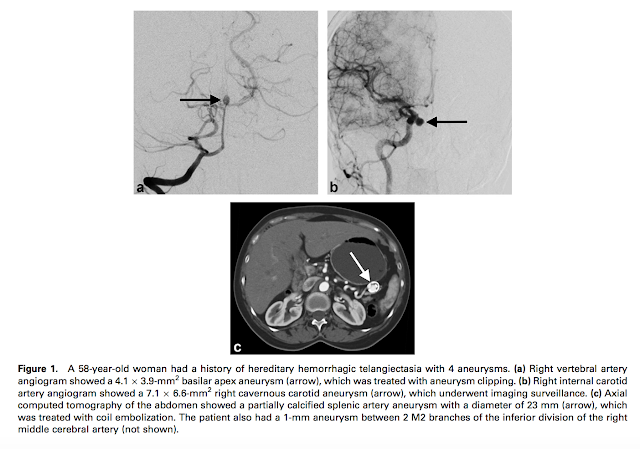Prevalence of and Factors Associated with Arterial Aneurysms in Patients with Hereditary Hemorrhagic Telangiectasia: 17-Year Retrospective Series of 418 Patients
Clinical question
What is the prevalence of and characteristics associated with the presence of aneurysms in patients with hereditary hemorrhagic telangiectasia (HHT)?
Take away point
Compared to the general population, the prevalence of intracranial and visceral arterial aneurysms is higher in this specific cohort with HHT. Older age, unrelated AVMs and ACVRL1 mutation were associated with having an aneurysm.
Reference
Prevalence of and Factors Associated with Arterial Aneurysms in Patients with Hereditary Hemorrhagic Telangiectasia: 17-Year Retrospective Series of 418 patients (2021). Ring, N., et al. Journal of Vascular and Interventional Radiology, Volume 32: 1661-1669.
Click here for abstract
Study design
Retrospective, observational and descriptive study.
Funding Source
No funding.
Setting
Single center; HHT Center of Excellence
Figure

Summary
The study was performed at a single center, which is established as a center of excellence. A total of 418 patients with HHT were identified via chart review. The presence and characteristics (eg size, number and location) were collected. Regression modeling was performed to evaluate the following potential associations, which are known to be associated with an increased risk of aneurysms: older age, male sex, smoking, alcohol, hypertension, hyperlipidemia, genetic mutations, the presence of arteriovenous malformations unrelated to aneurysms and HHT-related genetic mutations.
Out of 418 patients, 43 (10.3%) patients had at least one aneurysm, with a total of 73 aneurysms. Eighteen (4.3%) had intracranial aneurysms and twenty patients had visceral aneurysms (4.8%), which included splenic, renal, hepatic and pancreatic aneurysms. Less than two percent were pulmonary aneurysms unrelated to AVM’s, thoracic aortic aneurysm and coronary artery aneurysms. Please see figure one for a case with multiple arterial aneurysms. Of the Curaçao criteria, only the presence of unrelated aneurysms was statistically significant. The mean Curaçao score was significantly higher in patients with aneurysms. Patients with an ACVRL1 mutation had the highest rate of arterial aneurysms (20.0%). Results from the regression analysis demonstrated presence of the ACVRL1 mutation, unrelated AVMs and older age significantly associated with having at least one aneurysm.
Meta-analyses describe the prevalence of intracranial aneurysms as 1.8-3.2% in patients without comorbidities, compared to 4.3% of patients in the present study. Prevalence of visceral artery aneurysms in the general population is 0.1-2.0%, compared to 4.8% of patients in the present study.
A particular limitation discussed within this study surrounds the association between an unrelated AVM and an unrelated arterial aneurysm. Due to this finding, the patients underwent additional screening and may have been more likely to have an incidental aneurysm discovered. The nature of the study, single center and retrospective, limits the conclusions. The benefits of screening require further research, as the study underscores the uncertainties surrounding screening for brain AVMs in patients with HHT.
This study demonstrates a higher rate of intracranial and visceral arterial aneurysms in their cohort of HHT patients when compared to the general population. As discussed by the authors, the largest limitation is comparing these results to the general population. The rate of aneurysms in the general population is based on research that excluded “comorbidities”. What comorbidities did they exclude and were these excluded in the present study? HHT is not an isolated diagnosis and so the small, though significant, percentage difference between the two groups could possibly be explained by comorbidities. The single-center nature of the study may also limit the conclusion regarding increased aneurysms among patients with the ACVRL1 mutation. Given HHT is an autosomal dominant genetic disorder, the same mutation may be expressed in one family living in a similar geographic area. The higher percentage of patients with ACVRL1 mutation may have allowed increased power to reach significance.
Commentary
Overall this is an excellent foundational paper for future prospective studies. Establishing an appropriate comparison group would likely strengthen the conclusions and help develop screening applications regarding frequency, age initiation, and risk stratification.
Post Author
Marissa Stumbras, MD
Interventional Radiology Resident, PGY3
Oregon Health & Science University
@MarissaStumbras
Post Author
Marissa Stumbras, MD
Interventional Radiology Resident, PGY3
Oregon Health & Science University
@MarissaStumbras
Edited and formatted by @NingchengLi
Interventional Radiology Resident
Dotter Institute, Oregon Health and Science University
No comments:
Post a Comment
Note: Only a member of this blog may post a comment.